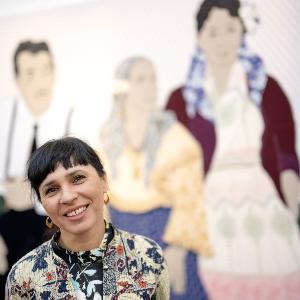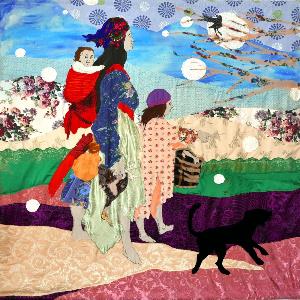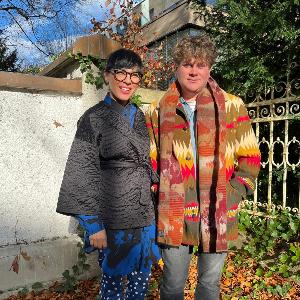The Roma in Munich: making gaps in art history visible
4 Dec 2024
Artist Małgorzata Mirga-Tas is exploring a fatal chapter in Munich’s history of the Roma and Sinti people, who were persecuted by the Nazis.
4 Dec 2024
Artist Małgorzata Mirga-Tas is exploring a fatal chapter in Munich’s history of the Roma and Sinti people, who were persecuted by the Nazis.

at an exhibition of her works in the Gothenburg “Konsthall” | © picture alliance / TT NYHETSBYR?N
Internationally celebrated artist Małgorzata Mirga-Tas is currently a fellow at LMU’s Käte Hamburger Kolleg global dis:connect In her work, Mirga-Tas addresses the lives of Roma and Sinti people. As artist-in-residence at LMU, she is collaborating with art historian Wojciech Szymański with an historical perspective on the visibility of Roma in Munich.
To this end, the pair are carrying out research in archives and museums for traces going back to the late 19th century. They will be presenting their initial findings on 9 December at an Artist Talk.
In our interview, Mirga-Tas and art history professor Burcu Dogramaci, director at global dis:connect, discuss the project and their cooperation.
Mirga-Tas caused a major international sensation and challenged art historiography at the Polish Pavilion at the 59th Venice Biennale and at the Documenta exhibition in Kassel.Burcu Dogramaci, director at the Käte Hamburger Research Centre global dis:connect

Małgorzata Mirga-Tas, Out of Egypt from Out of Egypt series (2020–2021), courtesy of the artist. | © Małgorzata Mirga-Tas
How did the cooperation with Małgorzata Mirga-Tas at the Käte Hamburger Research Centre global dis:connect come about?
Burcu Dogramaci: In 2022, Mirga-Tas caused a major international sensation and challenged art historiography at the Polish Pavilion at the 59th Venice Biennale and at the Documenta exhibition in Kassel. With the textile collages she creates with materials from within her Roma community, the artist interweaves the everyday lives of Roma people with art and visual history. She emphasizes community action and living, with a special focus on the roles of women. In addition, she explores stereotypes, exclusions, and omissions in art history.
When Mirga-Tas and curator and art historian Wojciech Szymański sent us a proposal for a project about Roma and Sinti in the context of the Munich art scene, we were immediately convinced. The topic embodies the central theme of the research center, the interplay of connectivity and disconnectivity in processes of globalization, in an exciting manner – for example, in its treatment of cultures of remembrance and processes of history formation. We’re delighted that internationally in-demand artist Małgorzata Mirga-Tas has taken up our invitation despite her many obligations – her works are currently being exhibited at Tate St Ives and she’s also preparing shows at the National Portrait Gallery in London and at the Kunsthaus Bregenz.
Ms. Mirga-Tas, what do you hope from your role as artist fellow?
Małgorzata Mirga-Tas: I’m working on a new project and exhibition devoted to the (in)visibility of Roma in the modern art world. A special focus is on the city of Munich around the turn of the century. My residency at the Käte Hamburger Research Centre global dis:connect seems like an excellent opportunity to realize these aims.
Over recent years, art-based research has evolved into an equitable form of research in the global academic world. Artists are increasingly being invited to take part in purely academic projects. Their contributions are particularly valuable where traditional methods of historical research reach their limits.
Burcu Dogramaci: From the beginning, the Käte Hamburger Research Centre global dis:connect has been inviting fellows not only from the world of research, but artists too. Artists often develop a different heuristic approach to the source material and can exercise more freedom in addressing the many omissions that characterize dis:connective art history and history more generally – as a result of colonial violence and exploitation, slavery, and exile and migration experiences.
In their project, Małgorzata Mirga-Tas and Wojciech Szymański are investigating, among other things, a still relatively obscure chapter of Munich history through the lens of art and art history. In 1899, the police established an intelligence service to monitor the Roma and Sinti population in Munich and built up a database as a method of recording and control. These early police records then played into the hands of the Nazis after 1933, who persecuted and imprisoned Roma and Sinti, abused them for medical experiments, and killed them. Consequently, the Porajmos [editor’s note: the Nazi genocide of Europe’s Roma population) has roots in the 19th century, and this is the framework around which the research of Małgorzata Mirga-Tas and Wojciech Szymański is constructed.
I’m interested in the visibility of Sinti and Roma in Munich, particularly in the second half of the 19th and the first half of the 20th century.Małgorzata Mirga-Tas

are currently guests at the Käte Hamburger Kolleg global dis:connect at LMU for their research on the visibility of Sinti and Roma in art history | © Sophie Eisenried / Käte Hamburger Kolleg global dis:connect
Is there anything you can tell us at this stage about your experiences from the project?
Małgorzata Mirga-Tas: I’m interested in the visibility of Sinti and Roma in Munich, particularly in the second half of the 19th and the first half of the 20th century. I was astonished that, despite the huge amount of modern and academic artworks depicting the Roma, and the police records that were created in Munich at this time, evidence of their presence is not easy to find in the archives.
Burcu Dogramaci: At an Artist Talk on 9 December, Małgorzata Mirga-Tas and Wojciech Szymański will present their current findings. Their research took them to the libraries, archives, and museums of Munich. They will also speak about their earlier art projects and exhibitions and about their work with various Roma communities in Poland and abroad.
Most of Mirga-Tas’s artworks are made with textiles, and this represents a major aspect of her artistic practice. For this reason, we invited Anna Schneider, curator at the Haus der Kunst, to talk with the artist about textiles. Schneider often includes textile art in her exhibitions and situates it in its sociopolitical context. Together with art historian Sophie Eisenried, the panel will ask questions about gaps in our knowledge about the lives, networks, and spaces of Roma and illuminate what role art and research can play in making these gaps visible.
In an Artist Talk on 9 December, they will be reporting on the research they have done in their joint project “History of Art/History of Violence: From the Belle Époque to the Genocide” and on the visibility of Roma in Munich. Małgorzata Mirga-Tas and Wojciech Szymański will talk with Anna Fenia Schneider, curator at the Haus der Kunst, and Sophie Eisenried from the Käte Hamburger Research Centre global dis:connect.
About the event: „Roma-non-Roma: in:visibilities and dis:connections“